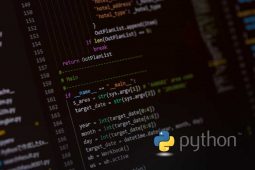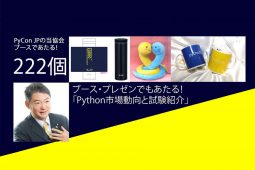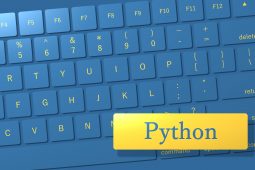Hello, Yoshimasa here. The Python Engineer Certification Exam I and my coworkers run has been taken by over 10,000 students in the past three years, and is on track to be taken by another 10,000 in its fourth year. A great many people taking the exam, and recently examinees from abroad are also increasing. For engineers from abroad who hope to work with Python in Japan, passing this test can not only prove their understanding of Python but technical Japanese conversation, as well.
The Python 3 Certified Engineer Basic Examination checks examinees on the basic grammar of Python, and as such is based on the pythonic philosophy. But what is pythonic?
The term was coined to indicate the philosophy of Python programming. Good programming requires a certain style, and writing code in a style inappropriate to the language can make it difficult to read, and might keep it from working properly. This is why programming style is considered so essential. The coding style for Python is encapsulated in the pythonic philosophy, and the aphorisms collected in The Zen of Python.
Since the exam is designed around pythonic and The Zen of Python, it is best for examinees to be familiar with both. Both of these topics are discussed in the articles below.
https://workinjapan.today/hightech/to-work-in-japan-learn-python-in-japanese/
https://workinjapan.today/hightech/japans-career-market-python/
Zen, of course, is a term from Japanese Buddhism. The Zen of Python is a collection of aphorisms that outline Python designing as a Zen-like practice. Running the command import this in a Python interpreter will display the aphorisms in English. Everyone who studies Python should read them carefully.
Now, here is a basic outline of the Python 3 Certified Engineer Basic Examination.
◆Test Outline Testing Period: Year Round
Testing Center: All Odyssey Communications CBT Test Centers in Japan
Registration Site: http://cbt.odyssey-com.co.jp/pythonic-exam.html
Testing Fee: 10,000 yen (tax not included) Student discount 5,000 yen (tax not included)
Test Name: Python 3 Certified Engineer Basic Examination
Certification: Python 3 Basic Grammar Certification
Summary: An exam based on basic Python grammar problems
Length: 40 multiple choice questions
Test Time: 60 minutes
Passing Line: 70% Correct
Scope: Questions are primarily taken from O’Reilly Japan’s Python Tutorial 3 rd Edition, in the following proportions. Some questions are based on basic, common knowledge.
| Chapters | Number of Questions | Proportion |
| Chapter 1: Whetting Your Appetite | 1 | 2.5% |
| Chapter 2: Using the Python Interpreter | 1 | 2.5% |
| Chapter 3 An Informal Introduction to Python | 6 | 15.0% |
| Chapter 4 More Control Flow Tools | 9 | 22.5% |
| Chapter 5: Data Structures | 7 | 17.5% |
| Chapter 6: Modules | 2 | 5.0% |
| Chapter 7: Input and Output | 1 | 2.5% |
| Chapter 8: Errors and Exceptions | 4 | 10.0% |
| Chapter 9 Classes | 2 | 5.0% |
| Chapter 10 Brief Tour of the Standard Library | 4 | 10.0% |
| Chapter 11: Brief Tour of the Standard Library—Part II | 1 | 2.5% |
| Chapter 12: Virtual Environments and Packages | 1 | 2.5% |
| Chapter 13: What Now? | 0 | 0.0% |
| Chapter 14: Interactive Input Editing and History Substitution | 1 | 2.5% |
| Total | 40 | 100.0% |
The exam consists of multiple choice questions, like he sample questions below.
Question 1: From the following, select the incorrect description of the characteristics of a tuple.
1. Tuples can be connected using the + symbol.
2. Tuples have an order, and can output the data using the index operation.
3. The data can be changed.
4. Objects other than hashable can be included.
Correct answer: 3
One of a tuple’s defining characteristics is that the data cannot be changed.
Question 2: Select from the following statements the result after executing the following code.
a = [’a’, ’b’, ’c’]
{str (i): s for i, s in enumerate (a) }
1. {’0 ’, ’1 ’, ’2 ’}
2. {’0 ’: ’a’, ’1 ’: ’b’, ’2 ’: ’c’}
3. [’0 ’, ’1 ’, ’2 ’]
4.It will result an error.
Correct answer: 3
Now, let us look at how to pass this test. Engineers overseas taking certification exams in Japanese have lower passing rates than Japanese engineers. Many of the test questions use English in the code, but sometimes the nuances of the questions in Japanese are difficult to understand.
The following strategies may help non-Japanese speakers to pass successfully.
1) Read the source materials.a) The textbook for the Python 3 Certified Engineer Basic Examination is the Python Tutorial 3 rd Edition from O’Reilly Japan. This text was translated into Japanese, so there is inevitably some awkward language in the text. It can be difficult for non-native speakers to read and understand translated texts. Thus, I recommend reading and studying the original Python Tutorial. Nearly the entire test is based on this book, so if you understand the book, then you will have a much higher chance of passing.
2) Then, watch the test preparation videos below to become better able to understand the questions in Japanese.
a) There are official test videos on YouTube. Check the YouTube channel below for videos that look interesting, and watch them to get used to the Japanese questions.
https://www.youtube.com/results?search_query=pythonエンジニア認定基礎試験
3) Take a practice test in Japanese to familiarize yourself with the exam.
a) The following website offers free Python 3 Certified Engineer Basic Examination practice tests. They are definitely worth a look.
https://study.prime-strategy.co.jp/
At a fundamental level, the Python 3 Certified Engineer Basic Examination is based on pythonic and The Zen of Python, the style guides for Python coding. Simply studying on your own makes it difficult to know if you really grasp the principles of pythonic coding and The Zen of Python. This is the perfect opportunity to check your grasp.







